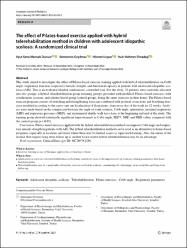| dc.contributor.author | Dursun, Ayşe Sena Manzak | |
| dc.contributor.author | Özyılmaz, Semiramis | |
| dc.contributor.author | Ucgun, Hikmet | |
| dc.contributor.author | Elmadağ, Nuh Mehmet | |
| dc.date.accessioned | 2024-01-04T12:29:09Z | |
| dc.date.available | 2024-01-04T12:29:09Z | |
| dc.date.issued | 2023 | en_US |
| dc.identifier.citation | Manzak Dursun, A. S., Ozyilmaz, S., Ucgun, H., & Elmadag, N. M. (2023). The effect of Pilates-based exercise applied with hybrid telerehabilitation method in children with adolescent idiopathic scoliosis: A randomized clinical trial. European journal of pediatrics, 10.1007/s00431-023-05340-2. Advance online publication. https://doi.org/10.1007/s00431-023-05340-2 | en_US |
| dc.identifier.uri | https://hdl.handle.net/20.500.12900/298 | |
| dc.description.abstract | This study aimed to investigate the effect of Pilates-based exercise training applied with hybrid telerehabilitation on Cobb angle, respiratory function, respiratory muscle strength, and functional capacity in patients with adolescent idiopathic scoliosis (AIS). This is an evaluator-blinded, randomized, controlled trial. For the study, 32 patients were randomly allocated into two groups: a hybrid telerehabilitation group (training group), provided with modified Pilates-based exercises with synchronous sessions; and a home-based group (control group), doing the same exercises in their home. The Pilates-based exercise program consists of stretching and strengthening exercises combined with postural corrections and breathing exercises modified according to the curve type and localization of the patients, done every day of the week for 12 weeks. Analyses were made based on the comparison between the angle of trunk rotation, Cobb angle, spirometry, maximal inspiratory (MIP) and expiratory pressures (MEP), and incremental shuttle walk tests done at the beginning and end of the study. The training group showed statistically significant improvements in Cobb angle, PEF%, MIP, and MEP values compared with the control group (p < 0.05). Conclusion: Pilates-based exercises applied with the hybrid telerehabilitation method can improve Cobb angle and respiratory muscle strength in patients with AIS. The hybrid telerehabilitation method can be used as an alternative to home-based programs, especially in locations and times where there may be limited access to supervised training. Also, the nature of the disease that requires long-term follow-up is another factor where hybrid telerehabilitation may be an advantage. | en_US |
| dc.language.iso | eng | en_US |
| dc.publisher | Springer | en_US |
| dc.relation.isversionof | 10.1007/s00431-023-05340-2 | en_US |
| dc.rights | info:eu-repo/semantics/openAccess | en_US |
| dc.subject | Ergen idiyopatik skolyoz | en_US |
| dc.subject | Adolescent idiopathic scoliosis | en_US |
| dc.subject | Cobb açısı | en_US |
| dc.subject | Cobb angle | en_US |
| dc.subject | Pilates egzersizleri | en_US |
| dc.subject | Pilates exercises | en_US |
| dc.subject | Solunum parametreleri | en_US |
| dc.subject | Respiratory parameters | en_US |
| dc.subject | Telerehabilitasyon | en_US |
| dc.subject | Telerehabilitation | en_US |
| dc.title | The effect of Pilates-based exercise applied with hybrid telerehabilitation method in children with adolescent idiopathic scoliosis: A randomized clinical trial | en_US |
| dc.type | article | en_US |
| dc.department | İstanbul Atlas Üniversitesi, Sağlık Bilimleri Fakültesi, Fizyoterapi ve Rehabilitasyon Bölümü | en_US |
| dc.authorid | Hikmet Ucgun / 0000-0002-7211-1805 | en_US |
| dc.contributor.institutionauthor | Ucgun, Hikmet | |
| dc.relation.journal | European Journal of Pediatrics | en_US |
| dc.relation.publicationcategory | Makale - Uluslararası Hakemli Dergi - Kurum Öğretim Elemanı | en_US |

















